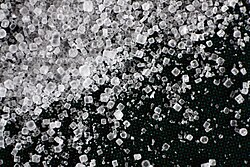Chemical change
A chemical change (chemical reaction) is a change of materials into other materials with different properties.
Chemical changes occur when a substance combines with another to form a new substance, or, chemical decomposition into two or more different substances. These processes are called chemical reactions.
Burning of wood is a chemical change as new substances which cannot be changed back (e.g. carbon dioxide) are formed. For example, if wood is burned in a fireplace, there is not wood anymore but ash. Other examples include burning of a candle, rusting of iron, baking a cake, etc. Special details that describe how a chemical change takes place are called chemical properties.
Compare: physical change. The opposite of a chemical change is a physical change. Physical changes are a change in which no new substances are formed, and the substance which is changed is the same. For instance, if a stick of wood is broken, there is still a stick of wood; it is just broken.
More examples include changes of shape, changes of states, passing electricity through a copper wire, breaking of wood, shattering of glass, pouring of water, etc. Special details which do not change in a substance without new substances being formed are called physical properties.
Chemical Change Media
A thermite reaction using iron(III) oxide. The sparks flying outwards are globules of molten iron trailing smoke in their wake.
Antoine Lavoisier developed the theory of combustion as a chemical reaction with oxygen.
An example of organic reaction: oxidation of ketones to esters with a peroxycarboxylic acid
Isomerization of azobenzene, induced by light (hν) or heat (Δ)
Sodium chloride is formed through the redox reaction of sodium metal and chlorine gas









